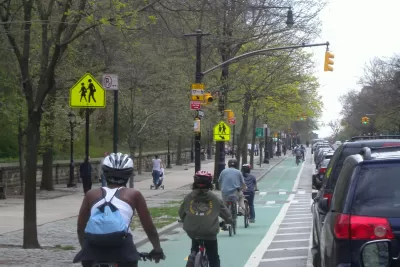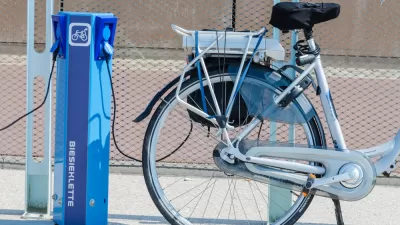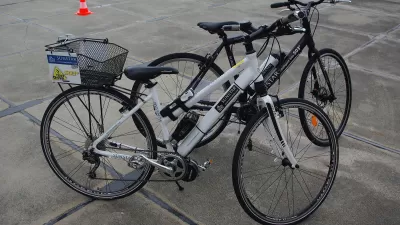Riders of electric and non-electric bikes alike agree that they would ride more if they felt safer on city streets, signaling a need for an increased focus on bike infrastructure.

“With battery-powered motors that assist riders as they pedal, e-bikes enable a broader range of people to make more and longer trips than traditional bikes. And they are cheaper, more efficient, and less resource-intensive to manufacture than electric cars.” Like electric cars, e-bikes require infrastructure improvements to make their widespread use practical and safe.
“There is no great mystery in how to get more people to ride e-bikes (as well as traditional bikes),” writes Ira Boudway in Bloomberg. “In polling commissioned by the advocacy group PeopleforBikes in 2018, nearly 70% of respondents across eight U.S. cities said that roads are not safe enough for families to bike and, of those, 63% said they would ride if they felt safer.” Research shows that “In city after city, when protected bike lanes are added to roadways, ridership increases.”
New bike infrastructure doesn’t have to be expensive, notes Boudway. “Fortunately, thanks to decades of spending on road and highway building, the infrastructure needed to create these networks already exists. Cities don’t need to pour asphalt; they just need to commandeer some of the surplus of streets from cars.”
Boudway points out that a majority of Americans support more bike and pedestrian infrastructure when polled, yet progress remains painfully slow as city leaders give in to the NIMBY minorities who protest loudest.
FULL STORY: How to Make a City Safer for E-Bikes? Think Infrastructure

Study: Maui’s Plan to Convert Vacation Rentals to Long-Term Housing Could Cause Nearly $1 Billion Economic Loss
The plan would reduce visitor accommodation by 25,% resulting in 1,900 jobs lost.

North Texas Transit Leaders Tout Benefits of TOD for Growing Region
At a summit focused on transit-oriented development, policymakers discussed how North Texas’ expanded light rail system can serve as a tool for economic growth.

Using Old Oil and Gas Wells for Green Energy Storage
Penn State researchers have found that repurposing abandoned oil and gas wells for geothermal-assisted compressed-air energy storage can boost efficiency, reduce environmental risks, and support clean energy and job transitions.

Houston Mayor Promises Dedicated Austin Street Bike Lane After Public Backlash
Although the one-way bike lane won’t be protected by physical barriers, the proposal is an improvement over the mayor’s initial plan to only include sharrows on the Austin Street project.

How Atlanta Built 7,000 Housing Units in 3 Years
The city’s comprehensive, neighborhood-focused housing strategy focuses on identifying properties and land that can be repurposed for housing and encouraging development in underserved neighborhoods.

Philadelphia Could Lose Free Transit Program
The city’s upcoming budget doesn’t include the Zero Fare program, which offers free SEPTA fare to more than 24,000 residents.
Urban Design for Planners 1: Software Tools
This six-course series explores essential urban design concepts using open source software and equips planners with the tools they need to participate fully in the urban design process.
Planning for Universal Design
Learn the tools for implementing Universal Design in planning regulations.
Borough of Carlisle
Caltrans
Heyer Gruel & Associates PA
Institute for Housing and Urban Development Studies (IHS)
City of Grandview
Harvard GSD Executive Education
Salt Lake City
NYU Wagner Graduate School of Public Service
City of Cambridge, Maryland





























